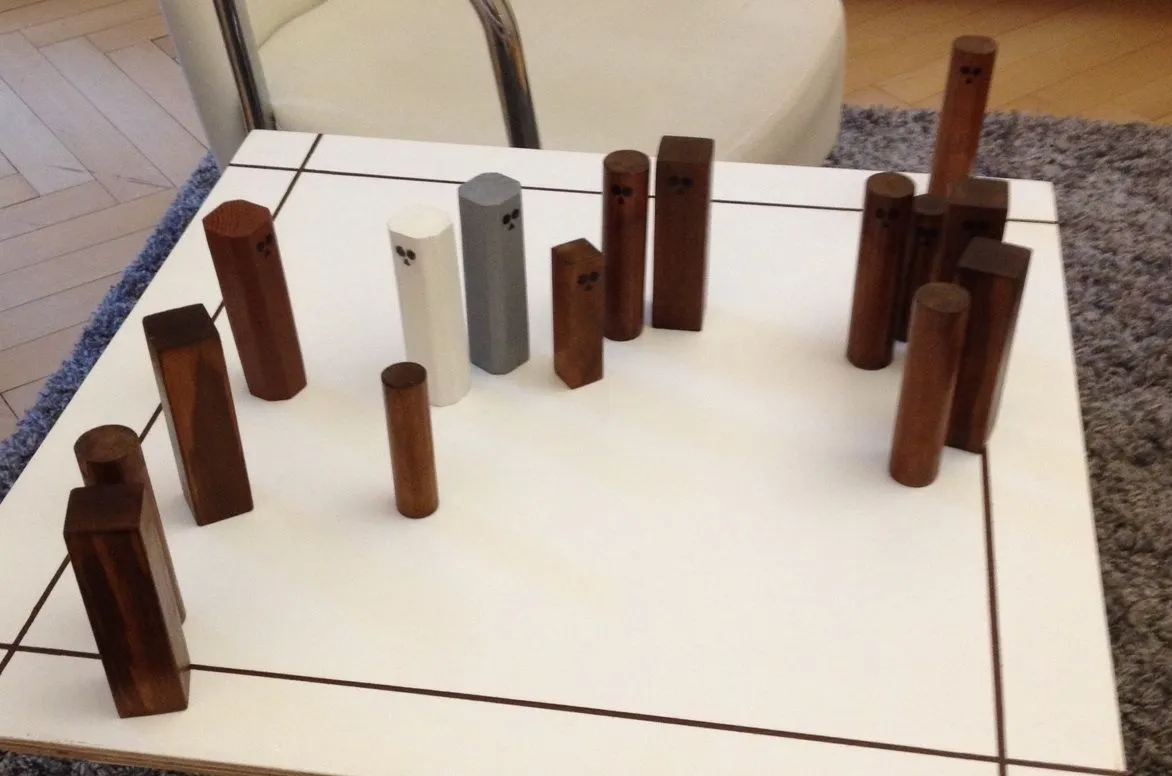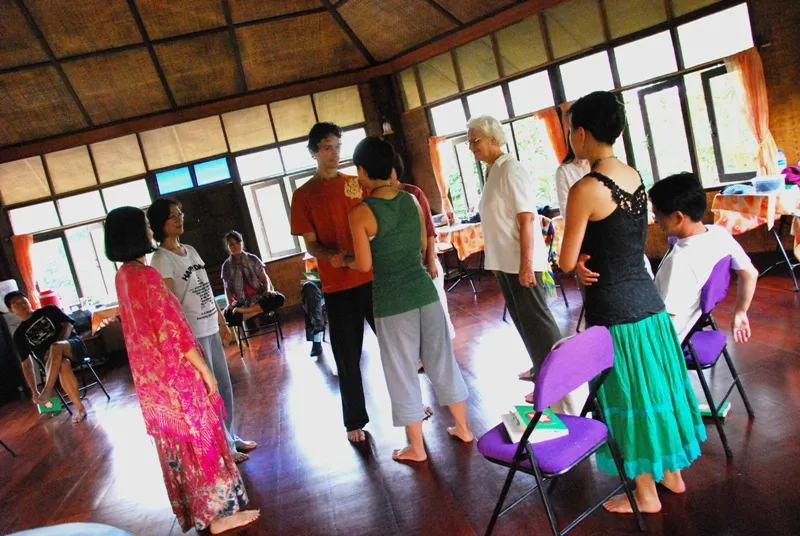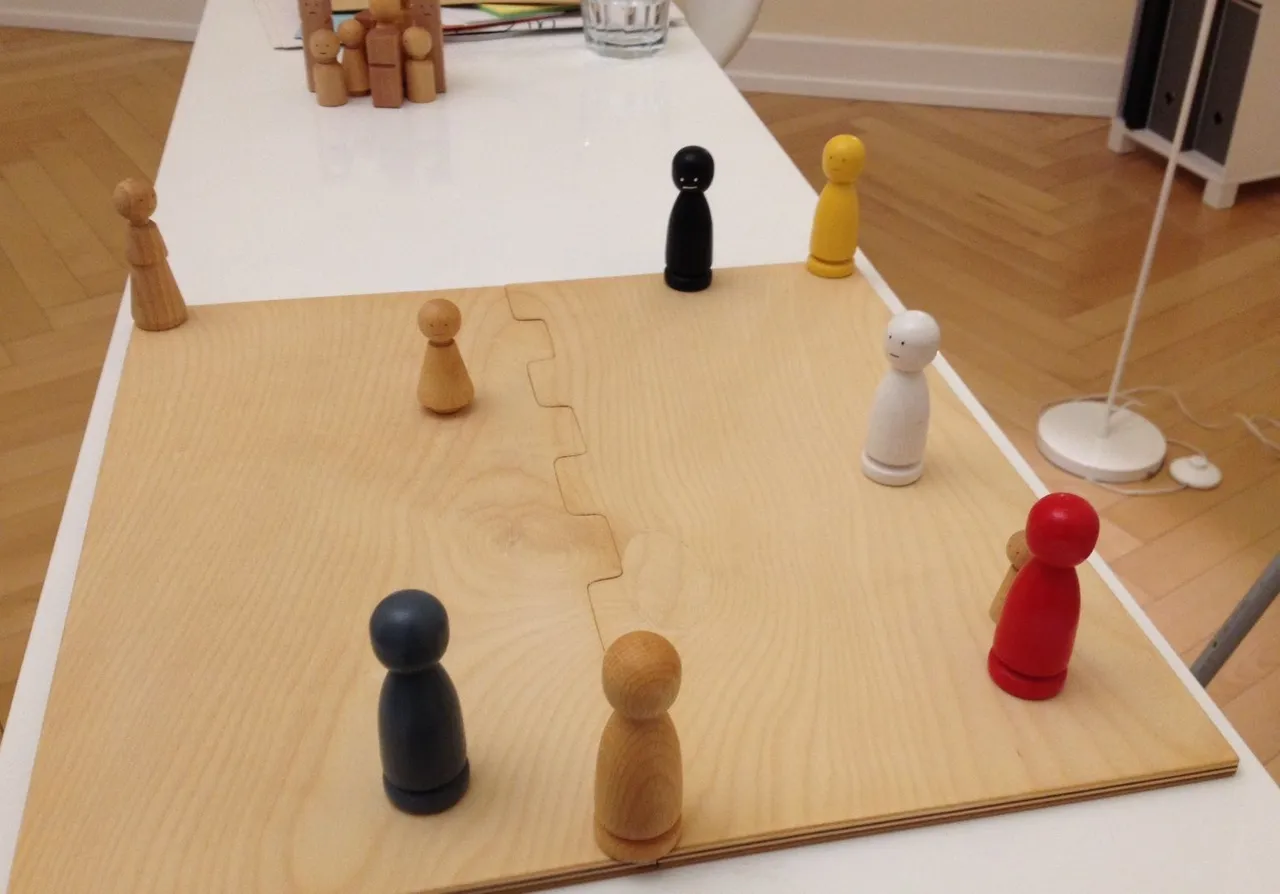Dear reader,
Have you ever made a drawing of your relationships? In particular those with your family and got an instant insight about it? No? Or do you find it unusual to approach the core of a thing by means of the method of drawing or arranging?
Than I would like you to offer the systemic integrative method of a "family board".
But let me first depict it.
If I were to ask you which symbol (object, animal, color, smell, etc.) you would give for a person who is extremely unpleasant to you: what symbol would that be?
I would think of a barking dog, for example, when I think of a person who is not well disposed towards me or who has been criticizing me sharply. Or a cardinal's robe for a person who can see right through me. Or a rock/stone for a person who seems impenetrable.
Using the family board is a constructivist approach - according to family constellations work which differs from the phenomenological approach in that it is not real people who are set up, but figures or rather they symbolize people or specific problems.
Here is an example:

This family board was put up in a session I led. I won't make an interpretation in order to protect my clients privacy.
The phenomenological approach became famous in Germany mainly because of the constellation work according to Bert Hellinger - who is discussed very controversial. I call him because of completeness and his fame. As far as I know, he was the first to make this method widely "popular". In my education he didn't play a role. The advantage of the constructivist method is that it comes about with less effort and not all people are convinced of the phenomenon of the representative family member. On the other hand, it is easier for us to give a symbol or a certain color or shape to a matter in our life. However, both methods are successfully applied and, depending on what people prefer, are involved in systemic work with clients.

As there is no real good wiki publishing in English, I translate and quote from the German version:
Origin and similar procedures
In the psychodrama, the Austrian doctor Jakob Moreno chose a representative for the persons concerned in a conflict to be dealt with. The representatives had to dramaturgically portray that conflict in their roles (as opposed to family jobs).
The "Family Sculpture", developed by Virginia Satir (Palo Alto Group): This method already used spatial arrangements among the (partly real present) family members, whereby the main focus was/is initially on the current relationship system of the respective client's family, and secondly not so much on the spatial arrangement alone, but rather on the physical sculptures or postures that were/are reproduced (from linguistically metaphorical references of the client in relationship problem descriptions).
Thus, the created family sculpture (external illustration) enables the respective client to depict family relationships in a non-verbal way and to reconstruct (interior, sometimes linguistically represented) conflicts (from the picture of family sculpture). On this (symptomatic) basis the process work (often reframing) was done by Virginia Satir. During the "Family Reconstruction" Virginia Satir added the multi-generational perspective.
Applications from hypnotherapy according to Milton H. Erickson were characteristic for the semantics within the family constellation.
Equilibrium and order:
Iván Böszörményi-Nagy, Geraldine M. Spark (Invisible bonds. The dynamics of family systems), USA 1965 (English 1973); see also Parentification.
Bert Hellinger is responsible for the additional affiliation (binding) to the respective system.
I mentioned V. Satir and her group in a former article of mine.
What is the benefit of using a family board? You can look at the board from different perspectives. Mainly, one gets the possibility to position the persons involved in such a way as it is perceived from one's own point of view. At the same time, an external perspective is taken and it is possible to try out new positions and let them have an effect on you. You can set an "actual" constellation and then a "target"(required) constellation. The latter can serve as a goal. Figures vary in For working with a 'classic family board' the following are also suitable While working with the board and a client the most interesting question after the board is done is: People tend not to place such persons (persona non grata) whom they do not want in their lives. But it is precisely those who are the ones who should definitely be set up or, if this is too painful, those who are to be mentioned, because it must be clear that an important person is missing. You can either leave them there or take them off the board again. But now, knowing that this was done (!). In my penultimate article I mentioned the subject of excluding unpleasant people and why it is better to choose an integrative form of confrontation. If only as a substitute. The visibility of loved or unloved people makes the family board in my eyes so successful -among other things - in its application. You can otherwise waste a lot of words and as an consultant you can spend a painful lot of time to find out where the family is stuck. I tried, believe me. and were you able to tell immediately where the shoe pinched? It's hard for me anyway, so working with things is much easier. And if I were asked to place my family by means of figures, I would think less about words and just start at first. It should be noted that the method is not suitable for everyone. A systemic consultant must test and evaluate this. There are people who have no connection to act in a playful way. But you would be surprised how many indeed have! I don't give you an interpretation on this either but rather I ask you, what do you see? From what I experienced within myself and others by using the board is, that if there were difficulties in placing the figures, this already was a sign for something. When you have troubles in deciding where your spouse is supposed to be, then it can, but does not necessarily have to be an indication that the person in the job is either not sure where his partner actually stands (emotionally) or speculates on the basis of this person or isn't sure him- or herself. As I have been able to observe, it can be particularly surprising for those involved witnesses (e. g. couples) to see how the other person places his system. One client said something like "I'm shocked that you're putting the system in this way! I never would have thought so!" I was able to observe how astonishment was accompanied by compassion and how understanding of each other's situation immediately set in. Making a situation visible is fundamentally different from conveying it verbally. While verbal communication is often accompanied by the desire to be right, as well as problems of definition and misunderstandings, visual communication conveys a result much more quickly, i. e. the perceived situation of a person. It is about reducing complexity. The infinitely varied interplay in a family is brought to a point and can be viewed from there. The family board as a visual aid can help all those involved to observe and think through the situation in peace and quiet, and possibly even illustrated triggers for feelings can be identified and experienced. This is also because this is a not yet accustomed form of communication in the consulting process of people, i. e. it interrupts the familiar. Circular questions (which I have already explained in an article of mine) can help to increase the collection of information and create even more transparency and plasticity. The family board makes social connections, in the family, visible to everyone, as well as relationship structures and functionalities. Was it the first time for you to hear of a family board? Please tell me, I would like to know. text sources:
https://en.wikipedia.org/wiki/Family_Constellations) picture sources: family board 1 and 2: my own pictures SteemSTEM is a community driven project which seeks to promote well written/informative Science Technology Engineering and Mathematics postings on Steemit. The project not only curates STEM posts on the platform through both voting and resteeming, but also re-distributes curation rewards as STEEM Power, to members of Steemit's growing scientific/tech community.VISIBILITY - Talk, talk, talk or see clearly from above?
Distance, angle and line of sight are understood to be primarily relevant among the persons who represent.
The advantages and quickly answered aspects are:
"Who does not stand on the board?"
Sometimes clients can't even narrow it down so well themselves, because much of what is conflict-rich doesn't get to the heart of the matter right away.Have you ever gone to a counseling interview right after work
Here is another constellation:

What impression does this constellation make on you?
Do you have any particular thoughts and feelings?
Count in how many figures you see, how they stand to each other, their distance and towards their faces direct.Possible impacts on witnesses
Information generated in this way may even be pronounced for the first time.
Thank you for reading!
https://en.wikipedia.org/wiki/Bert_Hellinger
http://www.systemagazin.de/bibliothek/texte/Ludewig_Systemische_Therapie.pdf (only German)
https://de.wikipedia.org/wiki/Familienaufstellung (German/translated quote)
http://www.v-r.de/pdf/titel_inhalt_und_leseprobe/116745/inhaltundleseprobe_978-3-525-45659-0.pdf (German)
http://www.systemagazin.de/bibliothek/texte/Ludewig_Systemische_Therapie.pdf (German)
family constellation phenomenological: Arden Wong [CC BY-SA 3.0 (https://creativecommons.org/licenses/by-sa/3.0)], via Wikimedia Commons
